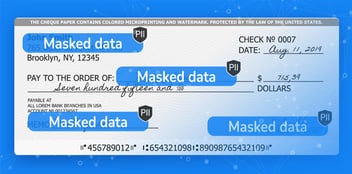Pseudonymization and tokenization are two popular, but distinct, methods of data protection that are cornerstones in any company’s data privacy toolkit.
Table of Contents
What is Pseudonymization?
What is Tokenization?
Pseudonymization vs Tokenization: Key Differences
Pseudonymization vs Tokenization: Benefits and Limitations
Pseudonymization vs Tokenization: Both Benefit from a Business Entity Approach
What is Pseudonymization?
Pseudonymization is a technique that replaces Personally Identifiable Information (PII), such as names, addresses, and dates of birth, with a unique identifier or code. Pseudonymized data reduces the risk of data breaches and unauthorized access to information, while retaining its usefulness for business operations. This makes pseudonymization a particularly useful tool for organizations that use data for analytics, research, marketing, or for sharing with third parties.
Unlike other data protection methods, such as data masking, pseudonymization is typically reversible. Sensitive data can be re-identified via a controlled process, which is why pseudonymization is often used in combination with other forms of data protection, like data masking tools.
Pseudonymization intentionally retains some information that can be used to re-identify individuals, which is why it’s commonly used in situations where data needs to be linked to a specific person or group. For example, imagine that a hospital needs to share patient information with researchers. It can use pseudonymization to replace patient names with a unique identifier so that the data can be analyzed without revealing any identities. Later, if the hospital needs to follow up with the patients, they can use the unique identifier to re-identify them.
Pseudonymization is an essential part of the European Union’s General Data Protection Regulation (GDPR), but to effectively safeguard sensitive information, it must be done in a specific way. According to Article 4 of GDPR, pseudonymization is achieved when PII is not able to be attributed to a specific data subject without using additional information.
Pseudonymization can be achieved through different methods, such as encryption or hashing. Encryption involves encoding or protecting data using a key, while hashing transforms the original data into a fixed-length string of characters. The appropriate method of pseudonymization depends on the specific use case and organizational needs.
What is Tokenization?
Data tokenization tools replace sensitive data with a unique token or identifier, which represents the original data. The original data is stored in a secure location, and the token is used in place of the original data.
Tokens are essentially randomized data strings that have no exploitable value or meaning. However, they can retain certain characteristics of the original data, such as its format or length, to support business operations while still maintaining user privacy.
With tokenization, personal or sensitive information is never stored in its original form in a database or transmitted over networks. Because of this, tokenization is considered one of the most secure ways to protect data and is frequently used for PII and financial information, including bank account numbers, passport numbers, credit card numbers, and Social Security Numbers.
For example, when customers use a credit card to purchase a product, their information is tokenized, and the tokens are sent to the payment processor. The payment processor stores the tokens in its system and sends the original data to the credit card company for processing. This allows the credit card company to process transactions without having access to the sensitive customer's information.
Tokenization can be achieved through different methods, such as format-preserving encryption (FPE) or random tokenization. FPE encrypts the data while preserving its original format, while random tokenization generates a random token that has no relation to the original data.
Like pseudonymization, tokenization can also be reversible, depending on the method used. Reversible tokenization involves storing a key that can be used to retrieve the original data from the token, while irreversible tokenization involves generating a token that can't be reversed.
Pseudonymization vs Tokenization: Key Differences
The following table summarizes the key differences between pseudonymization vs tokenization:
|
Characteristic |
Pseudonymization |
Tokenization |
|
Encryption method |
Unique algorithm |
Randomly generated token |
|
Retention of original data |
PII, enabling re-identification |
None – token stored instead |
|
Comparative security level |
Weaker (since PII stored) |
Stronger |
|
Most common use |
Cross-system sharing/linking |
Transaction processing |
|
Type of data protected |
PII (name, address, DoB…) |
Credit card and financial |
Pseudonymization vs Tokenization: Benefits and Limitations
Both pseudonymization and tokenization offer significant benefits for data protection, including:
-
Improved data security
By replacing sensitive data with unique identifiers or tokens, pseudonymization and tokenization make it more difficult for unauthorized users to access and use sensitive information. -
Enhanced privacy
Pseudonymization and tokenization help protect privacy by ensuring that sensitive information isn’t accessible to unauthorized parties. -
Compliance with data protection regulations
Many industries are subject to strict regulations that require the protection of sensitive data, such as healthcare and financial services. The combination of pseudonymization and tokenization can help businesses comply with these regulations by providing an effective data protection under every circumstance. -
Data analysis
Pseudonymization and tokenization enable businesses to analyze data without compromising privacy.
Along with these benefits, both pseudonymization and tokenization also have their limitations.
With pseudonymization, the risk of re-identification of anonymized data always exists. Determined attackers can combine pseudonymized data with other available information to potentially identify individuals in a dataset. Additionally, pseudonymization can result in a loss of data quality, which can make it challenging for enterprises to conduct analytics accurately. Another challenge for enterprises is that as the size of the datasets increases, so too does the cost and complexity.
Tokenization also has its limitations. The most significant is the risk associated with storing original sensitive data in one centralized token vault. This can result in bottlenecks when scaling up data, increased risk of a mass breach, and difficulties ensuring referential and format integrity of tokens across systems.
Pseudonymization vs Tokenization: Both Benefit from a Business Entity Approach
The way to reap the benefits of pseudonymization and tokenization is via entity-based data masking technology, which integrates data from multiple sources and organizes it by business entity (customer, store, device). The data for each business entity instance is managed and stored in its own individually encrypted Micro-Database™.
By taking this approach, individual sensitive data isn’t centralized in one location, eliminating the risk of a mass data breach. So enterprises achieve maximum security, without compromising on data utility, productivity, or speed.













